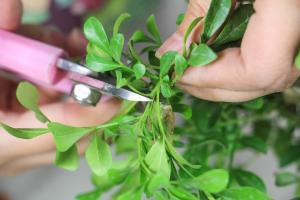Can Grafting in Tomato Plants Strengthen Resistance to Thermal Stress?
With climate change, the frequency and intensity of heat waves are on the rise, posing a significant threat to crop productivity. Thermal stress is one of the primary factors limiting the growth and development of tomato plants. Grafting has emerged as a potential tool to mitigate this problem. In this article, we will explore the possible benefits of grafting on tomato plants concerning thermal stress.
The Science Behind Grafting
Grafting is a horticultural technique that involves joining two different plant species into one. The process involves attaching the tissue of the scion (the upper part of the plant) to the rootstock (the lower part of the plant). Grafted plants often show improved resistance to biotic and abiotic stresses, like disease, pests, drought, and thermal stress. But how does grafting affect thermal stress tolerance in tomato plants?
The Effects of Grafting on Tomato Plants
Tomato plants can be grafted with various rootstocks, commonly from wild or resistant species like Solanum lycopersicoides, Solanum habrochaites, or Solanum pennellii. Scientific studies have shown that grafting can increase tomato plant resistance to thermal stress. One study conducted in South Korea found that tomato plants grafted onto Solanum habrochaites showed better tolerance to high-temperature stress than non-grafted plants. Moreover, the grafted plants showed higher antioxidant activity, which protected them from oxidative damage induced by high-temperature stress.
The Potential Mechanisms Behind Thermal Stress Tolerance in Grafted Tomato Plants
Several factors may contribute to the enhanced thermal stress tolerance in grafted tomato plants. First, the grafting process often triggers a systemic response in the plants, leading to changes in gene expression, hormone regulation, and metabolic pathways. Some genes associated with stress responses, such as heat shock proteins, may become more active in grafted plants. Second, grafting can impact the root system architecture and physiology, leading to better water and nutrient uptake and distribution, which are essential for plant growth and stress tolerance. Third, the rootstock may impart its own stress tolerance traits to the scion, providing extra protection against thermal stress.
The Practical Implications of Grafting on Tomato Farming
Grafting can be a beneficial tool for tomato farmers facing increasing thermal stress in their fields. By choosing suitable rootstocks, they can improve the thermal stress tolerance of their tomato plants, leading to higher yields and better quality fruits. Additionally, grafted plants may require less water and fertilizers, leading to lower costs and reduced environmental impact. However, grafting is an expensive and labor-intensive method, and requires specific skills and knowledge. Moreover, the quality and compatibility of the grafting materials must be ensured to avoid complications and failure.
Concluding Remarks
Grafting can provide a practical and effective way to enhance the thermal stress tolerance of tomato plants, but it is not a universal solution. Farmers must weigh the benefits and costs of grafting and choose a suitable approach based on their specific needs and circumstances. Research on grafting and thermal stress tolerance is ongoing, and further studies may provide new insights into the mechanisms and applications of this technique. Ultimately, grafting is an example of how modern technologies can help agriculture adapt to changing climates and conditions.

 how many times do yo...
how many times do yo... how many planted tre...
how many planted tre... how many pine trees ...
how many pine trees ... how many pecan trees...
how many pecan trees... how many plants comp...
how many plants comp... how many plants can ...
how many plants can ... how many plants and ...
how many plants and ... how many pepper plan...
how many pepper plan...


























